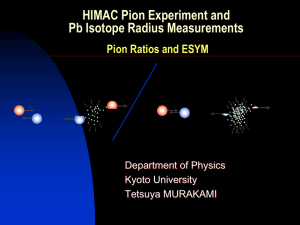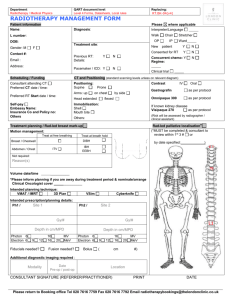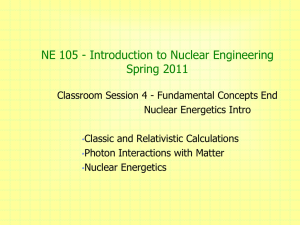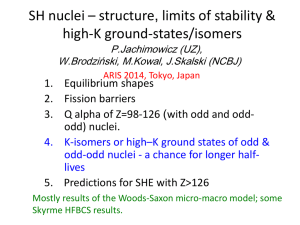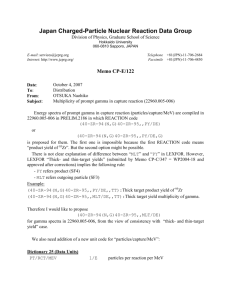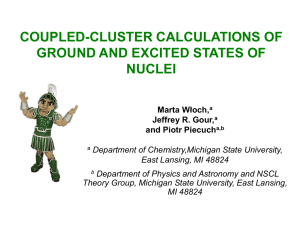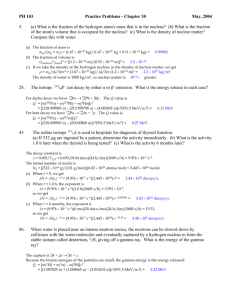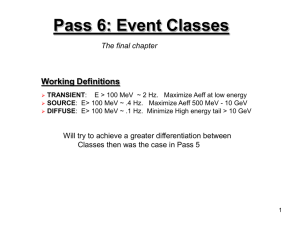Fig. 1. Two joined lemniscatoids simulating the fusionlike fission path.
advertisement
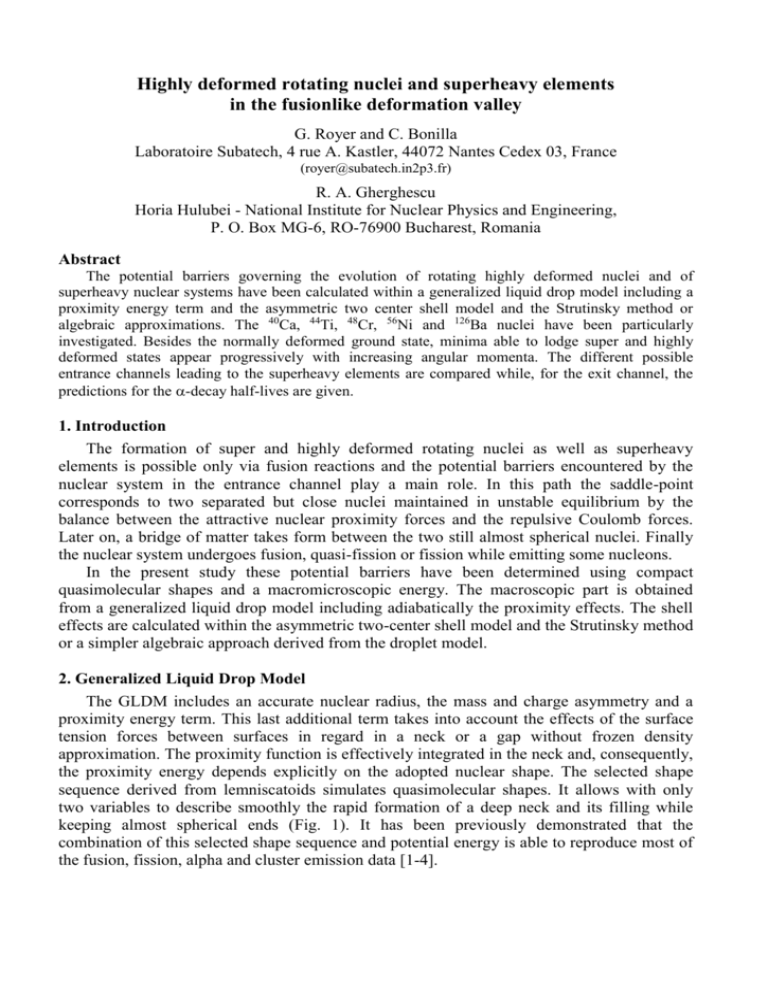
Highly deformed rotating nuclei and superheavy elements in the fusionlike deformation valley G. Royer and C. Bonilla Laboratoire Subatech, 4 rue A. Kastler, 44072 Nantes Cedex 03, France (royer@subatech.in2p3.fr) R. A. Gherghescu Horia Hulubei - National Institute for Nuclear Physics and Engineering, P. O. Box MG-6, RO-76900 Bucharest, Romania Abstract The potential barriers governing the evolution of rotating highly deformed nuclei and of superheavy nuclear systems have been calculated within a generalized liquid drop model including a proximity energy term and the asymmetric two center shell model and the Strutinsky method or algebraic approximations. The 40Ca, 44Ti, 48Cr, 56Ni and 126Ba nuclei have been particularly investigated. Besides the normally deformed ground state, minima able to lodge super and highly deformed states appear progressively with increasing angular momenta. The different possible entrance channels leading to the superheavy elements are compared while, for the exit channel, the predictions for the -decay half-lives are given. 1. Introduction The formation of super and highly deformed rotating nuclei as well as superheavy elements is possible only via fusion reactions and the potential barriers encountered by the nuclear system in the entrance channel play a main role. In this path the saddle-point corresponds to two separated but close nuclei maintained in unstable equilibrium by the balance between the attractive nuclear proximity forces and the repulsive Coulomb forces. Later on, a bridge of matter takes form between the two still almost spherical nuclei. Finally the nuclear system undergoes fusion, quasi-fission or fission while emitting some nucleons. In the present study these potential barriers have been determined using compact quasimolecular shapes and a macromicroscopic energy. The macroscopic part is obtained from a generalized liquid drop model including adiabatically the proximity effects. The shell effects are calculated within the asymmetric two-center shell model and the Strutinsky method or a simpler algebraic approach derived from the droplet model. 2. Generalized Liquid Drop Model The GLDM includes an accurate nuclear radius, the mass and charge asymmetry and a proximity energy term. This last additional term takes into account the effects of the surface tension forces between surfaces in regard in a neck or a gap without frozen density approximation. The proximity function is effectively integrated in the neck and, consequently, the proximity energy depends explicitly on the adopted nuclear shape. The selected shape sequence derived from lemniscatoids simulates quasimolecular shapes. It allows with only two variables to describe smoothly the rapid formation of a deep neck and its filling while keeping almost spherical ends (Fig. 1). It has been previously demonstrated that the combination of this selected shape sequence and potential energy is able to reproduce most of the fusion, fission, alpha and cluster emission data [1-4]. Fig. 1. Two joined lemniscatoids simulating the fusionlike fission path. 3. Highly deformed rotating nuclei In a previous study [5] the rotating Zr, Ce, Dy and Hg nuclei have been particularly studied. The main characteristics of the observed superdeformed states such as excitation energy, quadrupole moment, moment of inertia and spin range have been roughly reproduced. Here, firstly, predictions relative to the 126Ba nuclear system are given [6]. The 64 Ni(64Ni,2n)126Ba reaction is experimentally under investigation. The calculated potential barriers (Fig. 2.) are scission barriers preventing the separation of the fragments. The barrier top corresponds to two separated spheres maintained in unstable equilibrium by the balance between the attractive nuclear forces and the repulsive Coulomb ones. Macroscopically, with increasing angular momenta a relative plateau appears due to the proximity energy which introduces an inflection in the potential energy curve. Above around 50 a macroscopic highly deformed minimum appears at the bottom of the potential barrier. This potential pocket is removed by the centrifugal forces only for high angular momenta in reason of the high curvature and high values of the moment of inertia at the barrier top. This is a specificity of this deformation path to make compatible a high stability of rotating nuclei with low values of the fission barrier heights. The shell effects generate a normally deformed minimum close to the sphere. It corresponds to the slightly deformed ground state ( =0.26). It survives till around 60 . With increasing angular momenta the shell effects create a second superdeformed minimum in the macroscopic plateau, in the 46 to 80 range. It becomes the lowest one for 53 . Its moment of inertia evolves from 5223..75 2 .MeV 1 to 53.813..89 2 .MeV 1 , the quadrupole moment from 0.09 7.7 12.4 eb to 8.6 20.9 eb , from 0.4900..08 11 to 0.54 0.05 and the excitation energy from 23.5 MeV to 65 MeV. The limits of the uncertainty range correspond to the characteristics of the deformed nucleus lodging in the same potential pocket and having an energy of around 0.5 MeV above the minimum energy. A third highly deformed minimum exists from 55 to around 100 . It becomes the lowest minimum above 70 . Its moment of inertia varies from 66.2 35..54 to 84.855..44 2 .MeV 1 , the quadrupole moment from 14.5 12..44 to 21.7 22 eb, from 0.03 0.7800..04 09 to 0.96 0.04 and the excitation energy from 36.5 MeV to 83.5 MeV. Superdeformed rotational bands have been observed also recently in 40Ca [7]. The high spin states were populated via the reaction 28Si(20Ne,2 )40Ca with an effective beam energy of 80 MeV. The measured quadrupole moment for transition between states with spin from 16 to 2 is 1.80 00..39 29 eb ; the excitation energy varying from 22.1 to 5.6 MeV; the moment of inertia being around 8 2 .MeV 1 . The calculated barriers [8] are displayed in fig. 3. At l=0 there is a plateau but not deep second minimum. The first minimum around the sphere disappears at the highest angular momenta. With increasing angular momentum, a second highly deformed minimum appears and becomes the lowest one also around 17 . Its precise location is due to the shell effects but the underlying macroscopic energy plays also an important role, particularly the inflection in the curve due to the proximity energy. The calculated quadrupole moment for transition between states with spin from 16 to 2 varies then from 2.300..54 eb at 16 to 1.8 00..36 eb at 2 . The moment of inertia evolves from 9.4 10..08 to 8.310..16 2 .MeV 1 and the excitation energy from 24.3 to 9.0 MeV. These results agree with the recent experimental data except for the excitation energy at 2 which is too large. Some data have been extracted for 44Ti from light charged particle-heavy ion coincident measurements in the 16O+28Si reaction [9]. The involved highest excitation energy has led to a value of 35 for the critical angular momentum and an effective moment of inertia of around 11.8 2 .MeV 1 . The macromicroscopic l-dependent potential barriers are shown in fig. 4. A superdeformed shallow minimum appears only at 21 with a moment of inertia of 10.6 12 2 .MeV 1 and for an excitation energy of 34.5 MeV. It progressively moves to more external positions. The critical angular momentum is around 36 . Then the moment of inertia is 13.0 10..76 2 .MeV 1 and the excitation energy 70.5 MeV. These results agree roughly with the experimental data. The l-dependent potential barriers governing the 28Si+28Si reaction are given in Fig. 4. Experimentally, resonances at excitation energies of 70 MeV and spin 42 have been seen. For an angular momentum of 37 a highly deformed configuration having a moment of inertia of around 15 2 .MeV 1 has been observed. At low excitation energies two rotational bands have been detected. One band corresponds to transition between states with spin from 17 to 9 the excitation energy varying from 19.5 to 10.9 MeV (14.5 MeV for 13 ); the moment of inertia being around 11.5 2 .MeV 1 and the quadrupole moment roughly 2 eb. Within our approach, besides the spherical ground state we obtain a second minimum for angular momenta varying from 12 to 50 . For l = 42 its excitation energy is 69.4 MeV while at l=37 the moment of inertia is 17.811..66 2 .MeV 1 . For spin from 17 to 12 , the excitation energy varies from 23.5 MeV to 18.0 MeV; the moment of inertia from 14.111..21 to 13.510..39 2 .MeV 1 , and the quadrupole moment from 2.800..67 to 2.500..76 eb. At low spins our results seem to slightly overestimate the excitation energy and the deformation, besides the macromicroscopic second well appears at a too high spin. Nevertheless there is no fundamental disagreement and the existence of hyperdeformed configurations is naturally accounted for. Finally the macromicroscopic potential barriers governing the evolution of the 12C+36Ar, 16 O+32S, 20Ne+28Si and 24Mg+24Mg nuclear systems leading to the 48Cr nucleus are displayed in the lower part of Fig. 4. The persistence of a slightly deformed minimum in all cases at low angular momentum suggests a non spherical ground state of 48Cr. A very deformed minimum appears at high spins. Fig. 2. Sum of the macroscopic (upper part) and macromicroscopic (lower part) symmetric deformation and rotational energies for 126Ba as functions of the distance r between the mass centres and the angular momentum ( unit). Fig. 3. Sum of the macromicroscopic deformation and rotational energies of the 20 Ne+20Ne nuclear system as functions of the distance r and the angular momentum. The vertical dashed line indicates the transition between one-body and twobody shapes. ==== Fig. 4. Same as Fig. 2 but for the 24 Mg+24Mg nuclear systems. 16 O+28Si, 28 Si+28Si, 12 C+36Ar, 16 O+32S, 20 Ne+28Si and Angular momenta around 30 seems to be the most favourable value range for stabilizing super and highly deformed states in this well. For the symmetric reaction, the behaviour is somewhat different and two minima are visible from roughly 20 to 35 . As the angular momentum increases, pockets are removed by centrifugal forces, the moment of inertia varying from 8.7 2 .MeV 1 at 5 to 11 2 .MeV 1 at 35 for the inner well and from 9.1 2 .MeV 1 at 20 to 20.0 2 .MeV 1 at 35 for the external potential well. The excitation energy varies from 37 MeV at 20 to 61 MeV at 35 for the outer pocket. Experimentally, in 24Mg+24Mg scattering tentative spins of 36, 38 and 40 have been assigned [10] to three resonant states at saddle-point energies from 63 to 70 MeV. Our calculated excitation energy and spin range agree also roughly with these experimental data. 4. On the superheavy elements The synthesis of very heavy elements has apparently strongly advanced recently using cold (Zn on Pb [11]) and warm(Ca on U, Pu and Cm [12-14]) fusion reactions. The observed decay mode is mainly the emission. The analysis of the experimental data is discussed [15]. Recently [16] in a search for the production of element 112 in the 231 MeV 48Ca+238U reaction no any events have been observed and an upper limit cross section of 1.8 pb for evaporation residue-alpha events has been proposed. Within our approach in the same deformation path these reactions have been recently investigated [17]. Potential barriers against fusion via the cold reactions 70Zn and 82Se on 208Pb and warm fusion reactions 48Ca on 238U and 248Cm are displayed in Fig. 5. Different hypotheses have been assumed. The dashed line corresponds to the pure macroscopic potential energy. In ordinary fusion studies, it is only that barrier which is taken into account. The dashed-dotted line incorporates the shell corrections calculated empirically from the Droplet Model. The solid line is the sum of the GLDM macroscopic energy and of the shell effects calculated within the asymmetric two-center shell model and adjusted to reproduce the experimental or estimated (from the Thomas-Fermi model) Q value with a corrected factor beginning at the contact point. This supposes that the nuclear system has enough time to relax and built its shells and pairs and then that all the microscopic components contribute to the total energy. The first external top corresponds always to two separated sphere configurations; the attractive nuclear forces compensating for the repulsive Coulomb forces. At the contact point the first external top of the barrier is already passed. In the cold fusion reactions a wide potential pocket mainly due to the proximity energy appears at large deformations. From the Zn on Pb reaction, double hump fusion barriers appear and the inner peak is the highest for the heaviest systems. In the deep minimum between the two maxima incomplete fusion and fast fission processes may develop since the neck between the two nuclei is formed and exchanges of nucleons occur. The remaining excitation energy of the composite system is crucial to decide between complete fusion and fast fission. It depends on the pre or post equilibrium nature of the evaporation process of the excess neutron. In the warm fusion reactions, due to the asymmetry there is no double hump barriers. The barrier against reseparation being high and wide the system descends toward a quasi-spherical shape but with an excitation energy of more than 30 MeV if one assumes a full relaxation. The emission of several neutrons or even an particle is energetically possible. The dependence on the value of the next proton magic number is shown on Fig. 6 for the cold 86Kr + 208Pb fusion reaction and warm 50Ti + 248Cm one. The dashed curve corresponds to the pure macroscopic barrier and the dashed double dotted line takes into account the exact Q value. The solid curve corresponds to a proton magic number of 114, the dotted line to 120 and the dashed-dotted one to 126. The height of the first inner peak relatively to the sphere energy which governs the choice of the beam energy and the stability of the eventual compound nucleus increases with the proximity of the magic number. Nevertheless the main features of the barriers are the same which underline the importance of the macroscopic energy and particularly the proximity energy and the hypothesis of a full relaxation of the system contained in the exact Q value assumption. Recently, other reactions have been proposed to form these superheavy elements using radioactive ion beams or more symmetric reactions [18-19]. The macroscopic fusion barriers standing before some of these systems leading to the 270110 and 302120 nuclei are displayed in Fig. 7. It seems that it will be difficult to reach the ground state via the almost symmetric combinations. Furthermore it has been shown [1] that dynamic fusion barriers significantly higher than the static ones appear for Z1Z 2 2100 100. With increasing asymmetry the excitation energy increases strongly and it seems possible for some reactions to reach the external pocket and, later on, quasispherical configurations with little excitation energy using tunneling effects through the barriers. This does not prove the stability of the formed system. For the exit channel all the symmetric and asymmetric fission and emission barriers must be investigated. To determine these emission barriers the decay has been viewed [3] as a very asymmetric spontaneous fission within the generalized liquid drop model. The difference between the experimental and theoretical Q value has also been added at the sphere energy with a linear attenuation factor vanishing at the rupture point. Within such an unified fission model, the decay constant of the parent nucleus is simply defined as 0 P . There is no adjustable preformation factor. The assault frequency 0 has been chosen as 10 20 s 1 . The barrier penetrability P has been calculated within the general form of the action integral. The predicted decay half-lives agree with the experimental data in the whole mass range and also for the known heaviest elements [3, 16]. Analytic formulas have been proposed. For the even-even nuclei, the decay half-lives may be calculated using 1.5864 Z log10 T1/ 2 (s) 25.31 1.1629A1/ 6 Z . Q For the heaviest elements the theoretical Q value given by the Thomas-Fermi model has been selected since it reproduces correctly the mass decrements from Fermium to Z = 112. The table gives the predictions for the superheavy elements. If such nuclei exist, their halflives vary from microseconds to some days. Generally, for a given element, the half-lives increase with the neutron number. Curiously some nuclei (319,320126 and 317124) have a very low Q value (within the Thomas-Fermi model) and consequently a very high decay halflife. The calculation of the half-lives against symmetric and asymmetric fission is another challenge. Fig. 5. Fusion barriers versus the mass-centre distance r for the 70Zn and 82Se on 208Pb cold reactions and 48Ca on 238U and 248Cm warm reactions. Fig. 6. Fusion barriers versus r for the 86Kr + 208Pb and 50Ti + 248Cm reactions. Fig. 7. Macroscopic potential barriers for reactions leading to the The contact point is indicated by a vertical bar. Z 126 A Q Log[T] 124 A Q Log[T] 122 A Q Log[T] 120 A Q Log[T] 118 A Q Log[T] 117 A Q Log[T] 116 A Q Log[T] 115 A Q Log[T] 114 A Q Log[T] 312 16.78 -10.51 306 16.57 -10.6 300 14.23 -7.24 294 13.53 -6.41 291 12.79 -4.73 289 12.20 -4.12 286 11.65 -3.54 284 10.56 -0.02 283 9.79 1.38 313 16.22 -8.83 307 16.29 -9.37 301 14.14 -6.28 295 13.59 -5.75 292 12.59 -5.09 290 12.14 -3.47 287 11.52 -2.52 285 10.55 -0.74 284 9.64 1.10 314 15.95 -9.29 308 16.39 -10.37 302 14.3 -7.4 296 13.92 -7.17 293 12.49 -4.14 291 11.94 -3.58 288 11.55 -3.35 286 10.45 0.26 285 9.55 2.07 315 15.58 -7.86 309 16.74 -10.06 303 14.96 -7.75 297 13.78 -6.15 294 12.51 -4.96 292 11.93 -3.00 289 11.50 -2.51 287 10.48 -0.59 286 9.61 1.16 316 15.29 -8.26 310 16.58 -10.69 304 15.06 -8.74 298 13.58 -6.57 295 12.42 -4.02 293 11.91 -3.55 290 11.34 -2.89 288 10.34 0.54 287 9.53 2.10 317 15.0 -6.92 311 15.75 -8.61 305 15.16 -8.11 299 13.33 -5.32 296 12.52 -5.02 294 11.90 -2.96 291 11.33 -2.14 289 10.24 0.03 288 9.39 1.80 318 14.71 -7.3 312 15.54 -9.13 306 15.16 -8.95 300 13.63 -6.71 297 12.34 -3.88 295 11.80 -3.34 292 11.03 -2.16 290 10.15 1.07 289 9.08 3.49 270 319 6.71 18.6 313 14.91 -7.27 307 15.83 -9.21 301 13.91 -6.45 298 12.73 -5.49 296 11.59 -2.23 293 11.15 -1.74 291 9.88 1.03 290 8.73 3.95 110 and 320 6.89 16.7 314 14.49 -7.39 308 15.69 -9.83 302 13.95 -7.34 299 12.87 -5.03 297 11.97 -3.76 294 11.19 -2.60 292 9.75 2.28 291 8.66 4.90 302 120 nuclei. 321 10.9 1.94 315 14.23 -6.10 309 15.29 -8.39 303 14.07 -6.78 300 12.94 -5.96 298 12.16 -3.65 295 11.06 -1.55 293 9.69 1.56 292 8.47 4.85 322 12.16 -2.16 316 13.76 -6.08 310 15.35 -9.33 304 14.06 -7.57 301 13.05 -5.42 299 12.25 -4.41 296 11.33 -2.97 294 9.46 3.20 293 8.46 5.58 Table. Predicted Log10[T1/2(s)] for the superheavy elements versus the charge and mass of the mother nucleus and Q. 323 12.01 -0.96 317 7.1 15.53 311 14.5 -7.09 305 14.72 -7.94 302 13.07 -6.25 300 12.35 -4.13 297 11.38 -2.36 295 9.87 0.99 294 8.83 3.52 5. Conclusion The potential barriers standing in the fusionlike deformation path for rotating medium mass nuclei and for the heaviest elements have been determined within a macromicroscopic energy determined from a generalized liquid drop model and an asymmetric two center shell model or simpler algebraic expressions. For most of the nuclei, at low angular momenta the shell effects generate a minimum close to the sphere which lodges the normally deformed states. It disappears progressively with increasing angular momenta while the proximity energy and microscopic contributions create a second minimum where superdeformed states may survive. It becomes progressively the lowest one at intermediate spins. At still higher angular momenta, the minimum moves towards the foot of the external scission barrier leading to highly deformed quasimolecular states. The calculated characteristics roughly agree with the recent observed data on superdeformed and perhaps highly deformed bands in these nuclei. For the superheavy elements the cold fusion reactions take place in a double hump path. Incomplete fusion events may appear between the two peaks. An open question is to know whether at these large deformations the nucleon shells can take form before investigating a peculiar exit channel. The moment of the one neutron emission determines the nature of the reaction. For the heaviest systems and relatively symmetric reactions, the inner barrier is the highest. In the warm fusion reactions, there is no double hump barriers and the system descends automatically toward a quasispherical shape but with an excitation energy which is very high. The rapid emission of several neutrons or even an alpha particle is possible. So, it is important to be sure that the observed events are not incomplete fusion events. The alpha decay half-lives of these systems have been calculated within this GLDM adjusted to reproduce the experimental or the Thomas-Fermi model Q value. The agreement with experimental data is correct. Analytic formulas have been also proposed. References [1] G. Royer and B. Remaud, Nucl. Phys. A 444 (1985) 477. [2] G. Royer and K. Zbiri, Nucl. Phys. A 697 (2002) 630. [3] G. Royer, J. Phys. G 26 (2000) 1149. [4] G. Royer and R. Moustabchir, Nucl. Phys. A 683 (2001) 182. [5] R.A. Gherghescu and G. Royer, Int. J. Mod. Phys. E 9 (2000) 51. [6] G. Royer, C. Bonilla and R.A. Gherghescu, Phys. Rev C 67 (2003) 034315. [7] E. Ideguchi et al, Phys. Rev. Lett. 87 (2001) 222501. [8] G. Royer, C. Bonilla and R.A. Gherghescu, Phys. Rev. C 65 (2002) 067304. [9] P. Papka et al, Acta Phys. Pol. B 34 (2003) 2343. [10] A.H. Wuosmaa et al , Phys. Rev. C 41 (1990) 2666. [11] S. Hofmann et al, Z. Phys. A 354 (1996) 229. [12] Yu. Ts. Oganessian et al, Phys. Rev. Lett. 83 (1999) 3154. [13] Yu. Ts. Oganessian et al, Phys. Rev. C 62 (2000) 041604(R). [14] Yu. Ts. Oganessian et al, Phys. Rev. C 63 (2000) 011301(R). [15] P. Armbruster, E. Phys. J. A 7 (2000) 23. [16] W. Loveland et al, Phys. Rev. C 66 (2002) 044617. [17] G. Royer and R.A. Gherghescu, Nucl. Phys. A 699 (2002) 479. [18] J. Peter et al, Proc. Int. Conf. on nuclear physics at border lines, Lipari, Italy, 2001, World Scientific p 257. [19] Raj. K. Gupta et al, J. Phys. G 27 (2001) 867.

